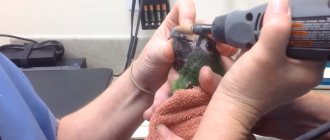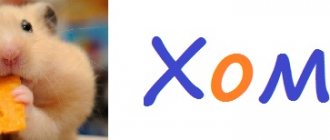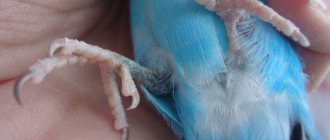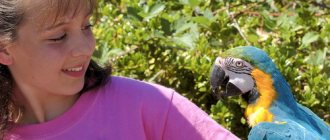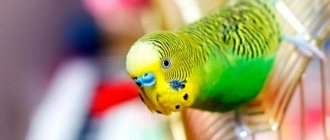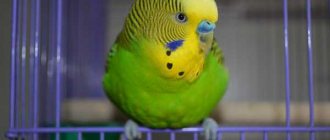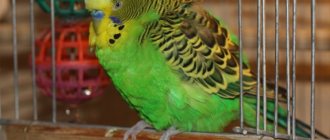- home
- Parrot
- Treatment
04/20/2019 Parrots are cheerful and emotional birds that are most often in a playful mood. There are situations when a pet changes its behavior: sneezes, becomes restless, or loses its appetite. The causes may be minor ailments or serious pathologies. The bird owner needs to understand why the parrot is sneezing and provide first aid correctly.
Cold prevention
Most poultry do not tolerate heat well and are afraid of draft winds. To ensure a healthy life for your bird, you need to place its cage fairly close to a window to allow sunlight to penetrate. But it is also necessary to arrange for her a cool corner in the shade of the cage, where she can rest from the hot sun. Change the water in the drinking bowl every day and feed your pet fresh food.
Corella Sneezes
Kukusik , urgently ask the doctor to take all possible tests from the bird, in particular a swab or nasal wash.
Standard set of tests: 1. smear from the crop for bacterial culture with determination of sensitivity, 2. smear from the cloaca for bacterial culture with determination of sensitivity, 3. droppings for protozoa and worm eggs (drops are looked at under a microscope, fresh, no more than 15 minutes). Worms do not reproduce every day - i.e. if there are worms in the body, worm eggs may not be present in the droppings, so this test, if suspicious symptoms persist, must be retaken after a few days. 4. droppings for scatology (the composition of the droppings is examined under a microscope - the presence of leukocytes and erythrocytes, fat, undigested fibers, mucus, blood), 5. sometimes droppings are taken for bacterial culture with sensitivity determination, 6. blood - general analysis, 7. blood - biochemistry (the number of indicators is determined by the doctor - it depends on the type of bird and the symptoms of the disease), 8. special tests - rinsing from the nose or throat or eye, scraping from the skin or beak - if necessary, 9. fluid (urine) analysis - if necessary.
How is bacterial culture done? The bacteria grows - a sample (droppings, rinsing, smear), prepared in a certain way, is applied to a sterile nutrient medium and placed in a thermostat. Bacteria multiply on this medium (or media). Afterwards, based on the degree of decomposition of the medium, the area of colonies, their number and growth time, the initial number of bacteria is judged, and the types of bacteria that have grown are also determined. Plus, if ordered, the sensitivity of bacteria to antibiotics is determined by placing filter paper discs soaked in a standard amount of antibiotic. Growth takes time - usually from five days to two weeks. When the bird’s condition is acute, there is no time to wait for growth - it simply will not live to see the test result, and it is necessary to prescribe the drug “according to the stars” - that is, with a wide spectrum, and based on the expected microorganisms. In the meantime, there is no acute problem - there is time to wait for the culture results and then see what is there, how to treat it and whether an antibiotic is needed at all. The situation is the same with fungi, only the media and preparations are different.
How to collect liquid from droppings (urine) for analysis? Place a bag or oilcloth at the bottom of the cage - liquid accumulates there - collect each portion as quickly as possible with a syringe (with a needle), store it in the refrigerator, then take it to the laboratory. The problem is that you need to dial 1 ml or even more - about this you need to find out in the laboratory how much they need.
Now you can do inhalations - place a bowl of boiling water next to the cage, put Zvezdochka balm or rubbing ointment for colds like Dr. Mom in it, cover the cage and bowl with a thick cloth so that the vapors spread throughout the cage. You can simply take the Star balm in a pencil and push it between the bars of the cage (also covered with a cloth). The nose can be washed 2 times a day. Into a syringe without a needle, take a saline solution (1 teaspoon per 200 ml of water), drop a little into the nostril and immediately pull it out with the syringe - see if there is any discharge - what color and density it is (this is important!). If there is no discharge, rinse each nostril 2-3 times, if there is discharge, until everything is washed out. At the same time, the bird must be held with its TAIL UP, muzzle down. Place a bowl under the bird so that the liquid drains there so that the secretions are not lost. Based on the color and density of the discharge, we will think about what to do. Do not use other drugs yet - they may distort the test results.
Treatment of colds in cockatiels
If you notice frequent sneezing, decreased activity, or trembling in your bird, you need to start treatment. What to do if your cockatiel sneezes? You need to move the cage with the sick parrot to a warm place. Next, you need to warm the bird under a lamp for half an hour. It is better to use special lamps from pet stores, but a regular table lamp will do. The main thing is that the lamp has a power of 40-50 W, does not blind the bird’s eyes and does not illuminate the entire cage, only half of it. The procedure must be repeated three to four times during the day. Heat can quickly restore the bird's condition and make it healthy again.
If symptoms do not disappear after a few days of treatment, contact your veterinary clinic. Don't neglect the bird's health.
What to do if your parrot sneezes
If a cockatiel parrot sneezes, the owner needs to quickly find out the reasons for this behavior. Due to accelerated metabolism, the disease can cause serious damage to health and even result in the death of the bird within 2-3 days.
Frequent dry sneezing
A common occurrence in birds is dry sneezing, which acts as a protective reaction of the body and does not pose a serious threat. It is not associated with any complex pathologies. However, to prevent this symptom from getting worse, it is recommended to take appropriate measures.
This type of sneezing can cause:
- bird fluff;
- room dust;
- pet hair;
- cereal shell.
Important! If sneezing is caused by dry air, you can quickly correct the situation with a spray bottle. The space around the cage must be moistened.
These types of pollutants lead to irritation of the mucous membranes. The situation is aggravated by low air humidity. As a result, trivial reasons often lead to the development of asthma and other pathologies of the bronchi and lungs. To reduce the risk of their occurrence, it is recommended to remove the husks from the feed and regularly do wet cleaning in the area with the poultry.
Sneezing and head shaking
If a cockatiel sneezes and its head shakes at the same time, this is a serious reason to be wary. Parasites can lead to this condition. Young and weak birds are especially susceptible to them. The first stages of infection are almost asymptomatic. And only the acute form is characterized by sneezing.
Important! Lack of timely treatment leads to death.
This disease is called sternostomosis. It is caused by Sternostoma tracheacolum mites, which penetrate the trachea and infect it. They enter the bird's body through water or food. In the respiratory system, mites multiply quickly. The parasite larvae attach to the trachea and feed on the parrot's blood. This causes twitching of the head and neck.
Ivermectin or other similar drugs will help cure the bird. The drug and its exact dosage are prescribed by a veterinarian after careful diagnosis and confirmation of the disease.
Wet sneeze
If a cockatiel sneezes with mucus, then most likely this will not lead to dangerous consequences. But in any case, the pet will need help. Wet sneezing can be caused by:
- Allergy. Pet parrots may have an allergic reaction to plants, aerosols, detergents and cleaners, and various scents.
- Infections. If sneezing with snot is infectious in nature, you should contact a veterinarian. Birds are treated with antibacterial drugs based on diagnostic results.
- Foreign body. Any small object that gets into the nasopharynx can lead to inflammation. Its rejection causes severe sneezing with mucus. And touching the beak will cause pain to the bird. If a foreign body is suspected, the assistance of a veterinarian will be required. Only he has the right to remove it. Independent manipulations are dangerous for your pet.
- Hypothermia. As well as the presence of drafts, cold drinking water and other factors can lead to wet sneezing in the cockatiel. For the same reason, the parrot often trembles. To improve the microclimate in the cage, it is enough to turn on an incandescent lamp with a power of 40–60 W nearby.
Swelling of the mucous membranes can be treated by inhalation with medicinal plants. For these purposes you will need 1 tbsp. l. pharmaceutical chamomile. It is poured with boiling water with the addition of 1 drop of eucalyptus oil. The container is placed near the cage and covered with a towel. It is recommended to perform such inhalations twice a day for 10–15 minutes.
Sneezing after eating
Sneezing in a cockatiel after eating or with food rejection indicates the presence of pathologies in the internal organs. Most likely, this symptom is accompanied by improper functioning of the goiter or stomach. Penetrating food is not able to descend into the stomach because its tissues are inflamed.
Important! If problems with internal organs are excluded, sneezing and regurgitation of food may occur due to low quality food or its monotony.
A veterinarian will help determine the exact cause of this problem. Often in this situation, it is recommended to wash the crop with a weak solution of tannin. If this manipulation is not enough, a course of antibiotics is prescribed.
Sneezing in a budgie
If you are the owner of a wavy cat who has begun to sneeze, do not rush to worry. There are several causes of sneezing.
Why does a budgerigar sneeze: 1. Molting period - During molting, the bird may sneeze due to its own feathers.
2. Cleaning feathers - wavy birds clean their feathers several times a day, and since they do this with their beak, particles of fluff can get into their nostrils, which causes sneezing.
3. Dry air - if the room where the parrot is, the air is too dry, it can cause the bird to sneeze.
If your parrot is sneezing and his nostrils remain dry, then you need to increase the humidity. To do this, you can hang a damp towel over the cage.
Never perform the procedure with a towel if the bird sneezes not through the nose, but through the beak, and there is discharge from the nose. This can worsen the condition of the wavy and aggravate the problem.
4. The bird often repeats after you. Parrots, who are taught by their owners to say words and imitate human sounds, can imitate you and imitate the sounds of sneezing they hear. In this case, all you should do is admire your pet's skills.
All the above reasons for sneezing mean there is nothing to worry about.
Follow the bird throughout the day. If you notice nasal discharge and frequent sneezing, then the cause is most likely a cold.
Causes of parrot sneezing
A parrot may sneeze sporadically or constantly. This is a reaction to external stimuli or a symptom of serious health problems.
The reasons may be as follows:
- When molting, a parrot's own down can cause irritation of the nasal mucosa. The parrot molts twice a year.
- Dry room air does not allow the bird to breathe normally; the mucous membrane dries out, becomes crusty and clogs the nasal passages.
- Allergy to new food, meadow hay, aromatic oils, wool, house dust.
- Colds as a result of drafts and low room temperatures.
- Viral, bacterial, parasitic diseases.
In any case, this cannot be ignored, and decisive measures must be taken immediately depending on the nature of the sneezing.
Corella does not eat or drink
Symptoms of water and food refusal can accompany many cockatiel diseases. In itself, it may indicate either food poisoning or a dangerous infection.
Sometimes a bird refuses to eat when circumstances change. It is common for a parrot to experience stress when there is a sudden change in environment. Therefore, if you just bought a bird, or moved to a new apartment, your cockatiel may refuse to eat due to stress, and not due to illness. In this case, you just have to wait until the parrot adapts to the new conditions, then he himself will start eating and drinking. As a rule, the adaptation period for cockatiels lasts no more than a couple of days.
A cockatiel may not eat or drink if it has diarrhea, a severe cold, or if it is injured. Experiencing weakness, the bird becomes inactive, does not want to feed, and looks tired. This is a common symptom, so along with it it is worth paying attention to other signs of disease in order to understand what is happening to the parrot.
The cockatiel has diarrhea
Diarrhea can be either normal food poisoning in your parrot or a sign of a serious infection.
In order to understand what causes diarrhea in a cockatiel parrot, it is worth observing your pet, remembering whether you changed its diet in the coming days, or whether the parrot’s food could have spoiled.
If you check the products and realize that everything is fine with them, the parrot’s diet does not change, and the bird’s diarrhea does not go away, then most likely it is not a case of food poisoning in the cockatiel.
If you often observe diarrhea in your pet, this is a reason to go to the veterinarian. Especially if the color of the bird's droppings has changed and become greenish or gray or reddish due to blood clots.
Diarrhea is often accompanied by changes in the bird's mood and behavior. The parrot becomes inactive, slow, and does not react to what is happening. Appetite is lost, the Corella parrot trembles and has a ruffled appearance - the bird experiences discomfort and pain. With such diarrhea, you should contact a qualified specialist. These symptoms confirm that the bird is sick, and not just food poisoning.
Corella creaks its beak
But the behavior of the cockatiel, when it begins to creak its beak, is not a symptom of disease. As a rule, in this way the bird simply cleans its beak, trying to grind it down a little. To help the bird take care of its beak, you can put a piece of chalk or a cuttlefish shell, which is sold in pet stores, in the cage.
When the cockatiel creaks its beak, it can express positive emotions - this is a kind of manifestation of the joy of a pet. Pay attention to the circumstances under which the bird squeaks (during feeding, while walking around the house, while communicating with the owner) - most likely, these moments evoke good emotions in the bird.
How to protect your bird from sneezing
Taking care of your pet is an essential condition for keeping a parrot at home. The owner must provide the bird with comfort and eliminate the influence of negative factors.
To prevent your parrot from getting sick, you need to follow preventive measures:
- ventilate the room, but at the same time protect the bird from drafts and dampness;
- do not smoke, do not spray aerosols indoors;
- remove fluff, feathers, droppings and food residues;
- disinfect the cage weekly;
- feed only proven mixtures and do not give potentially harmful foods;
- Monitor the cleanliness of water, feeders and drinkers.
A good help in prevention is vaccination, as well as seasonal strengthening of the immune system with vitamin supplements.
If a parrot sneezes, this is not a reason to panic, but the problem cannot be left unattended. It is necessary to identify the cause of atypical behavior in order to provide qualified assistance. Inaction or illiterate treatment will lead to disastrous results.
Digestive diseases
Diarrhea, vomiting, refusal of food, favorite treats, unstable stool, the presence of particles of undigested food, blood threads, clots in the stool, exhaustion, rapid weight loss are the main symptoms of diseases and pathologies of the gastrointestinal tract. The cockatiel is diagnosed with gastroenteritis and dysbacteriosis.
As a rule, malfunctions in the digestive tract are caused by violation of feeding rules and regulations, poor cage hygiene, feeding the bird with low-quality, moldy feed, and contaminated drinking water. Improper nutrition leads to metabolic disorders, an imbalance of beneficial microflora that takes part in the digestive processes, and severe poisoning.
A cockatiel may develop food allergies to certain food components. This condition is provoked by delicacies from our table, low-quality, low-grade ready-made food.
In addition to the main treatment, you need to adjust your pet’s diet. Anti-inflammatory, restorative, enzyme agents, special foods, probiotics, and homeopathic agents are used in therapy.
Parrot eats
Respiratory diseases
Prolonged hypothermia, drafts, decreased immune potential, and unfavorable living conditions often lead to the development of respiratory diseases in poultry.
The main symptoms of colds:
- lacrimation, swelling of the eyelids;
- cough, sneezing, difficulty breathing;
- decreased activity;
- poor condition of the pen;
- dull plumage;
- chills, trembling;
- copious discharge from the nostrils and eyes.
Corella sneezes, coughs, mucous, purulent exudate is released from the nostrils and eyes. The bird sits motionless at the bottom of the cage, constantly sleeps, and has no appetite.
Sick parrot. The disease is caused by unsanitary conditions, improper care
Some pathologies of the respiratory tract are accompanied by acute respiratory failure and can be caused by neoplasms, adhesions, and viral and bacterial infections.
A veterinarian or ornithologist will tell you how to treat a respiratory illness and what medications should be given to a sick bird. The specialist will prescribe a treatment course and optimal dosage.
Feather problems
Molting is a natural physiological process characterized by the replacement of old plumage with new ones. But if the parrot constantly plucks its feathers, itches until it bleeds, the molting is intense, prolonged or absent altogether, the bird’s feathers fall out from its tail and wings - this is an alarming symptom.
This condition can be caused by low-quality feed, an unbalanced diet, allergies, stress, fear, hypo-vitaminosis, hormonal imbalances, fungi, bacteria, endocrine pathologies.
Intensive shedding in cockatiels
Prolonged French molt, if a bird plucks feathers from its wing or tail, is most often provoked by chronic pathologies of the liver and kidneys, which can signal serious disorders in the body of the feathered pet.
The veterinarian will select the treatment regimen. At home, review the bird’s diet and install a UV lamp at a distance of 50 cm from the cage. The room temperature should always be between 22–24 degrees. When self-plucking, exclude sunflower seeds and protein feed from the diet. Increase the amount of mineral and vitamin supplements.

